NCERT Solutions | Class 12 Maths Chapter 13 | Probability

CBSE Solutions | Maths Class 12
Check the below NCERT Solutions for Class 12 Maths Chapter 13 Probability Pdf free download. NCERT Solutions Class 12 Maths were prepared based on the latest exam pattern. We have Provided Probability Class 12 Maths NCERT Solutions to help students understand the concept very well.
NCERT | Class 12 Maths
| Book: | National Council of Educational Research and Training (NCERT) |
|---|---|
| Board: | Central Board of Secondary Education (CBSE) |
| Class: | 12th |
| Subject: | Maths |
| Chapter: | 13 |
| Chapters Name: | Probability |
| Medium: | English |
Probability | Class 12 Maths | NCERT Books Solutions
NCERT Solutions for Class 12 Maths Chapter 13 Probability Ex 13.1
Ex 13.1 Class 12 Maths Question 1
Given that E and Fare events such that
P (E) = 0.6, P (F) = 0.3 and P(E∩F) = 0.2
find P(E|F) and P (F|E).
Solution.
Given: P (E)=0.6, P (F)=0.3, P (E ∩ F)=0.2
\(P(E|F)=\frac { P(E\cap F) }{ P(E) } =\frac { 0.2 }{ 0.3 } =\frac { 2 }{ 3 } \)
\(P(F|E)=\frac { P(E\cap F) }{ P(E) } =\frac { 0.2 }{ 0.6 } =\frac { 1 }{ 3 } \)
Ex 13.1 Class 12 Maths Question 2
Compute P(A|B) if P(B)=0.5 and P (A∩B) = 0.32.
Solution.
Given: P (B)=0.5, P(A∩B)=0.32
\(P(A|B)=\frac { P(A\cap B) }{ P(B) } =\frac { 0.32 }{ 0.50 } =\frac { 32 }{ 50 } =0.64 \)
Ex 13.1 Class 12 Maths Question 3.
If P (A)=0.8, P (B)=0.5 and P(B/A)=0.4, find
(i) P(A∩B)
(ii) P(A/B)
(iii)P(A∪B)
Solution.
(i) \(P(B/A)=\frac { P(A\cap B) }{ P(A) } \Rightarrow 0.4=\frac { P(A\cap B) }{ 0.8 } \)
∴ P(A∩B) = 0.4 x 0.8 = 0.32
(ii) P(A/B) = \(P(A/B)=\frac { P(A\cap B) }{ P(B) } =\frac { 0.32 }{ 0.5 } =\frac { 32 }{ 50 } =\frac { 16 }{ 25 } \)
(iii) P(A∪B) = P(A) + P(B) – P(A∩B)
= 0.8 + 0.5 – 0.32 = 1.30 – 0.32 = 0.98
Ex 13.1 Class 12 Maths Question 4.
Evaluate P(A∪B) if 2P(A) = P(B) = \(\frac { 5 }{ 13 }\) and P(A|B) = \(\frac { 2 }{ 5 }\).
Solution.
Given:
2P(A) = P(B) = \(\frac { 5 }{ 13 }\) and P(A|B) = \(\frac { 2 }{ 5 }\).
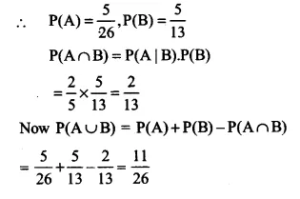
Ex 13.1 Class 12 Maths Question 5.
If P(A) = \(\frac { 6 }{ 11 }\),P(B) =\(\frac { 5 }{ 11 }\) and P(A∪B) = \(\frac { 7 }{ 11 }\),
Find
(i) P(A∩B)
(ii) P(A|B)
(iii) P(B|A)
Solution.
Given:
P(A) = \(\frac { 6 }{ 11 }\),P(B) =\(\frac { 5 }{ 11 }\) and P(A∪B) = \(\frac { 7 }{ 11 }\),
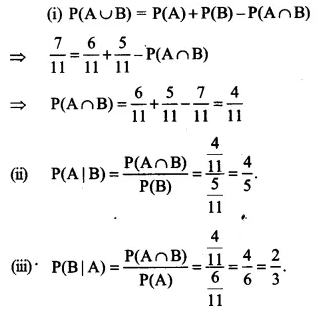
Ex 13.1 Class 12 Maths Question 6.
Determine P(E/F) in question 6 to 9:
A coin is tossed three times, where
(i) E: head on third toss F: heads on first two tosses.
(ii) E: at least two heads F : at most two heads
(iii) E: at most two tails F: at least one tail
Solution.
(i) E = Head occurs on third toss as {HHH, HTH, THH, TTH}
F : Heads on first two tosses = {HHH, HHT} E ∩ F = {HHH}
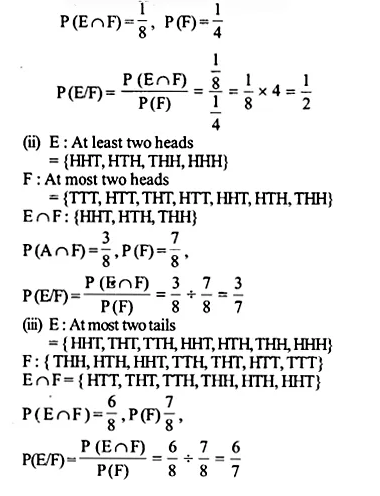
Ex 13.1 Class 12 Maths Question 7.
Two coins are tossed once
(i) E: tail appears on one coin F: one coin shows head
(ii) E: no tail appears F: no head appears.
Solution.
S = {HH, TH, HT, TT} n (S) = 4
(i) E : tail appears on one coin
E = {TH,HT}, P{E) = \(\frac { 1 }{ 2 }\)
F : one coin shows head,
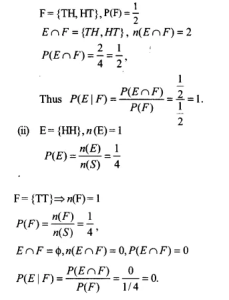
Ex 13.1 Class 12 Maths Question 8.
A die is thrown three times.
E: 4 appears on the third toss
F: 6 and 5 appears respectively on first two tosses.
Solution.
A die is thrown three times E : 4 appears on third toss = {(1,1,4), (1,2,4), (1,3,4), (1,4,4), (1,5,4),
(1.6.4),(2,1,4), (2,2,4), (2,3,4), (2,4,4), (2,5,4),
(2.6.4), (3,1,4), (3,2,4), (3,3,4), (3,4,4), (3,5,4),
(3.6.4), (4,1,4), (4,2,4), (4,3,4), (4,4,4), (4,5,4),
(4.6.4), (5,1,4), (5,2,4), (5,3,4), (5,4,4), (5,5,4),
(5.6.4), (6,1,4), (6,2,4), (6,3,4), (6,4,4), (6,5,4),
(6.6.4)}
These are 36 cases
F: 6 and 5 appears respectively on first two tosses = {(6,5,1), (6,5,2), (6,5,3), (6,5,4), (6, 5,5), (6,5,6)}
These are six cases E ∩ F = {6,5,4}
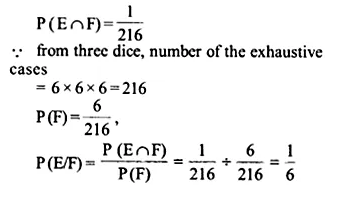
Ex 13.1 Class 12 Maths Question 9.
Mother, father and son line up at random for a family picture:
E: son on one end, F: father in middle
Solution.
Mother (m), Father (f) and son (s) line up at random E : son on one end: {(s, m, f), (s, f, m), (f, m, s), (m, f, s)}
F: Father in middle: {(m, f,s), (s, f, m), (s, f, m)}
E∩F = {(m, f, s), (s, f, m)}

Ex 13.1 Class 12 Maths Question 10.
A Mack and a red die are rolled.
(a) Find the conditional probability of obtaining a sum greater than 9, given that the black die resulted in a 5.
(b) Find the conditional probability of obtaining the sum 8, given that the red die resulted in a number less than 4.
Solution.
(a) n(S) = 6 x 6 = 36
Let A represent obtaining a sum greater than 9 and B represents black die resulted in a 5.
A= {46,64,55,36,63,45,54,65,56,66}
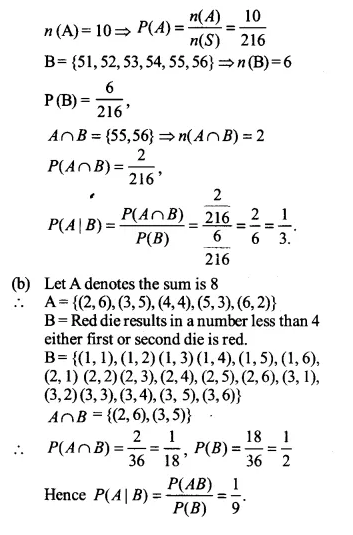
Ex 13.1 Class 12 Maths Question 11
A fair die is rolled. Consider events E = {1,3,5} F = {2,3} and G = {2,3,4,5}, Find
(i) P(E|F) and P(F|E)
(ii) P(E|G) and P(G|E)
(iii) P((E ∪ F) |G) and P (E ∩ F)|G)
Solution.
(i) E = {1,3,5}, F = {2,3},E∩F = {3}
P(E) = \(\frac { 3 }{ 6 }\) ,P(F) = \(\frac { 2 }{ 6 }\),P(E∩F) = \(\frac { 1 }{ 6 }\),
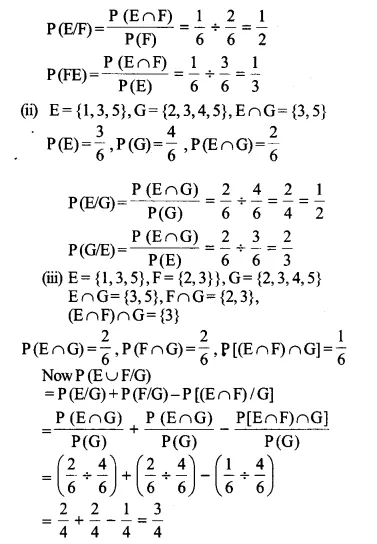

Ex 13.1 Class 12 Maths Question 12.
Assume that each child born is equally likely to be a boy or a girl. If a family has two children, what is the conditional probability that both are girls given that
(i) the youngest is a girl,
(ii) at least one is girl?
Solution.
Let first and second girls are denoted by G1 and G2 and Boys by B1 and B2.
Sample space
S = {(G1G2),(G1B2),(G2B1),(B1B2)}
Let A = Both the children are girls = {G1G2}
B = youngest child is a girls = {G1G2, B1G2}
C = at least one is a girl = {G1B2, G1G2, B1G2}
A∩B = {G1G2},
A∩C = {G1G2}
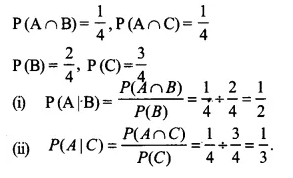
Ex 13.1 Class 12 Maths Question 13.
An instructor has a question bank consisting of 300 easy True/ False questions, 200 difficult True/ False questions, 500 easy multiple choice questions and 400 difficult multiple choice questions. If a question is selected at random from the question bank, what is the probability that it will be an easy question given that it is a multiple choice question?
Solution.
The given data may be tabulated as
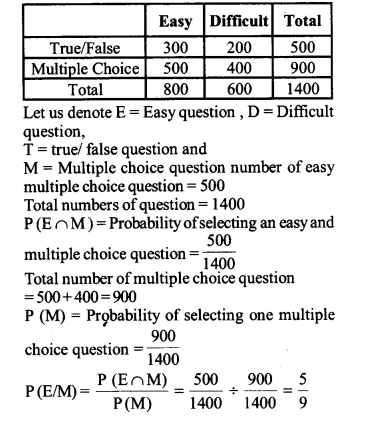
Ex 13.1 Class 12 Maths Question 14.
Given that the two numbers appearing on throwing two dice are different. Find the probability of the event ‘the sum of numbers on the dice is 4’.
Solution.
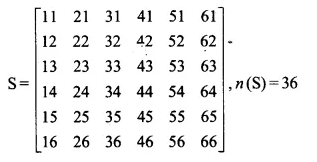
Let A represents the event “the sum of numbers on the dice is 4”
and B represents the event “the two numbers appearing on throwing two dice are different.”
A = {13,22,31}, n (A) = 3
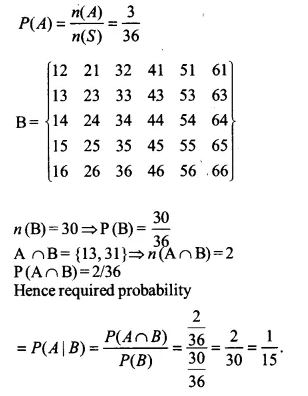
Ex 13.1 Class 12 Maths Question 15.
Consider the experiment of throwing a die, if a multiple of 3 comes up, throw the die again and if any other number comes, toss a coin. Find the conditional probability of the event ‘the coin shows a tail’ given that ‘at least one die shows a 3’.
Solution.
Let there be n throws in which a multiple of 3 occurs every time.
Probability of getting a multiple of 3 (i.e. 3 or 6)
in one throw = \(\frac { 2 }{ 6 }\) = \(\frac { 1 }{ 3 }\)
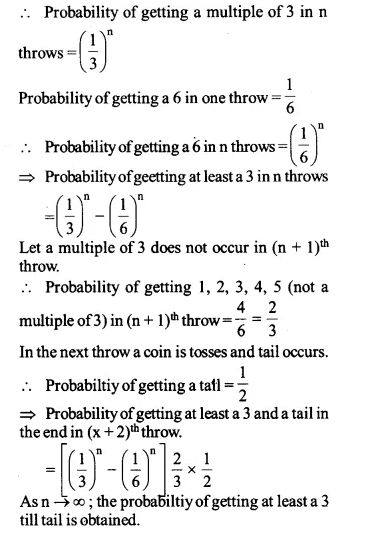
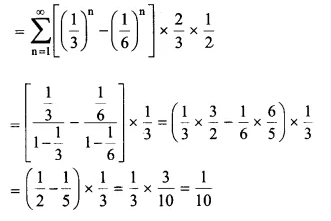
In each of the following choose the correct answer:
Ex 13.1 Class 12 Maths Question 16.
If P(A) = \(\frac { 1 }{ 2 }\), P (B) = 0 then P (A | B) is
(a) 0
(b) \(\frac { 1 }{ 2 }\)
(c) not defined
(d) 1
Solution.
P(A) = P(B) = 0
∴ P(A∩B) = 0
\(\therefore P(A|B)=\frac { P(A\cap B) }{ P(B) } =\frac { 0 }{ 0 } \)
Thus option C is correct
Question 17.
If A and B are events such that P(A | B) = P(B | A) then
(a) A⊂B but A≠B
(b) A = B
(c) A∩B = φ
(d) P(A) = P(B)
Solution.
P(A | B) = P(B | A)
Thus option (d) is correct.
\(\frac { P(A\cap B) }{ P(B) } =\frac { P(B\cap A) }{ P(A) } \)
⇒ P(A) = P(B)
We hope the NCERT Solutions for Class 12 Maths Chapter 13 Probability Ex 13.1 help you. If you have any query regarding NCERT Solutions for Class 12 Maths Chapter 13 Probability Ex 13.1, drop a comment below and we will get back to you at the earliest.
NCERT Solutions for Class 12 Maths Chapter 13 Probability Ex 13.2
Ex 13.2 Class 12 Maths Question 1.
<If P(A) = \(\frac { 3 }{ 5 }\) and P(B) = \(\frac { 1 }{ 5 }\), find P(A∩B) if A and B are independent events.
Solution.
A and B are independent if P (A ∩ B)
\(=P(A)\times P(B)=\frac { 3 }{ 5 } \times \frac { 1 }{ 5 } =\frac { 3 }{ 25 } \)
Ex 13.2 Class 12 Maths Question 2.
Two cards are drawn at random and without replacement from a pack of 52 playing cards.Find the probability that both the cards are black.
Solution.
Number of exhaustive cases = 52
Number of black cards = 26
One black card may be drawn in 26 ways
∴ Probability of getting a black card,
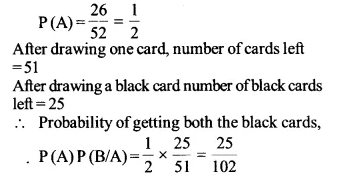
Ex 13.2 Class 12 Maths Question 3.
A box of oranges is inspected by examining three randomly selected oranges drawn without replacement. If all the three oranges are good, the box is approved for sale otherwise it is rejected. Find the probability that a box containing 15 oranges out of which 12 are good and 3 are bad ones will be approved for sale.
Solution.
S = {12 good oranges, 3 bad oranges),
n(S) = 15
P (a box is approved) = \(\frac { C(12,3) }{ C(15,3) } =\frac { 12\times 11\times 10 }{ 15\times 14\times 13 } =\frac { 44 }{ 91 } \)
Ex 13.2 Class 12 Maths Question 4.
A fair coin and an unbiased die are tossed. Let A be the event ‘head appears on the coin’ and B be the event ‘3 on the die’. Check whether A and B are independent events or not
Solution.
When a coin is thrown, head or tail will occur
Probability of getting head P(A) = \(\frac { 1 }{ 2 }\)
When a die is tossed 1,2,3,4, 5, 6 one of them will appear
∴ Probabillity of getting 3 = P(B) = \(\frac { 1 }{ 6 }\)
When a die and coin is tosses, total number of cases are
H1,H2,H3,H4,H5,H6
T1,T2,T3,T4,T5,T6
Head and 3 will occur only in 1 way
∴ Probability of getting head and \(3=\frac { 1 }{ 12 }\)

Ex 13.2 Class 12 Maths Question 5.
A die marked 1,2,3 in red and 4,5,6 in green is tossed. Let A be the event, ‘the number is even’, and B be the event, ‘the number is red’. Are A and B independent?
Solution.
Even numbers on die are 2,4,6
∴ Probability of getting even number
P(A) = \(\frac { 3 }{ 6 }\) = \(\frac { 1 }{ 2 }\)
There are two colours of the die – red and green.
Probability of getting red colour, P (B) = \(\frac { 1 }{ 2 }\)
Even number in red colour is 2
∴ Probability of getting red colour and even number
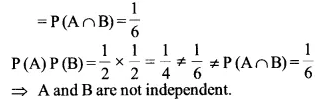
Ex 13.2 Class 12 Maths Question 6.
Let E and F be the events with P(E) = \(\frac { 3 }{ 5 }\), P (F) = \(\frac { 3 }{ 10 }\) and P (E ∩ F) = \(\frac { 1 }{ 5 }\). Are E and F independent?
Solution.
P(E) = \(\frac { 3 }{ 5 }\) ,P(F) = \(\frac { 3 }{ 10 }\),
∴ P (E) x P (F) = \(\frac { 3 }{ 5 } \times \frac { 3 }{ 10 } =\frac { 9 }{ 50 } \)
P(E∩F)≠P(E)xP(F)
∴ The event A and B are not independent.
Ex 13.2 Class 12 Maths Question 7.
Given that the events A and B are such that P(A) = \(\frac { 1 }{ 2 }\),P(A∪B) = \(\frac { 3 }{ 5 }\) and P(B) = p. Find p if they are
(i) mutually exclusive
(ii) independent.
Sol. Let P(A∩B) = x,Now P(A) = \(\frac { 1 }{ 2 }\) ,P(A∪B) = \(\frac { 3 }{ 5 }\), P(B) = P
P(A∪B) = P (A) + P (B) – P (A∩B)
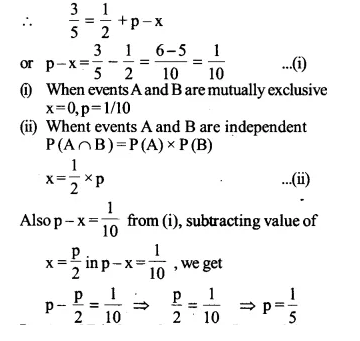
Ex 13.2 Class 12 Maths Question 8.
Let A and B independent events P(A) = 0.3 and P(B) = 0.4. Find
(i) P(A∩B)
(ii) P(A∪B)
(iii) P (A | B)
(iv) P(B | A)
Solution.
P (A) = 0.3,
P (B) = 0.4
A and B are independent events
(i) ∴ P (A∩B) = P (A). P (B) = 0.3 x 0.4 = 0.12.
(ii) P(A∪B) = P(A) + P(B) – P(A).P(B)
= 0.3 + 0.4 – 0.3 x 0.4 = 0.7 – 0.12 = 0.58.
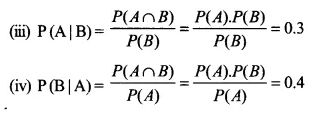
Ex 13.2 Class 12 Maths Question 9.
If A and B are two events, such that P (A) = \(\frac { 1 }{ 4 }\), P(B) = \(\frac { 1 }{ 2 }\),and P(A∩B) = \(\frac { 1 }{ 8 }\).Find P (not A and not B)
Solution.
Event not A and not B = \(\overline { A } \cap \overline { B } \)
\(P(\overline { A } \cap \overline { B } )=1-P(A\cup B)\)
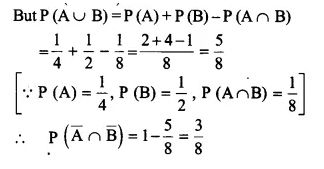
Ex 13.2 Class 12 Maths Question 10
Events A and B are such that
P(A) = \(\frac { 1 }{ 2 }\),P(B) = \(\frac { 7 }{ 12 }\) and P (not A or not B) = \(\frac { 1 }{ 4 }\). State whether A and Bare independent
Solution.
\(P(\overline { A } \cup \overline { B } )=1-P(A\cap B)\)
\(\Rightarrow \frac { 1 }{ 4 } =1-P(A\cap B)\)
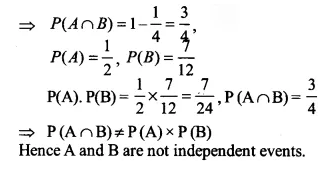
Ex 13.2 Class 12 Maths Question 11
Given two independent events A and B such that P (A) = 0.3, P(B) = 0.6. Find
(i) P(A and B)
(ii) P(A and not B)
(iii) P (A or B)
(iv) P (neither A nor B)
Solution.
(i) A and B are independent events
∴ P(A and B) = P(A∩B) = P(A) x P(B)
= 0.3 x 0.6 [ ∵P (A) 0.3), P (B) = 0.6]
∴ P(A and B) = 0.18
(ii) P(A and B) = and

Ex 13.2 Class 12 Maths Question 12
A die is tossed thrice. Find the probability of getting an odd number at least once.
Solution.
S = {1,2,3,4,5,6},n(S) = 6
Let A represents an odd number.
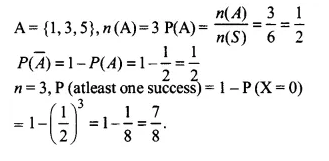
Ex 13.2 Class 12 Maths Question 13
Two balls are drawn at random with replacement from a box containing 10 black and 8 red balls. Find the probability that
(i) both balls are red.
(ii) first ball is “black and second is red.
(iii) one of them is black and other is red.
Solution.
S = {10 black balls, 8 red balls}, n (S) = 18
Let drawing of a red ball be a success.
A = {8 red balls}, n (A) = 8
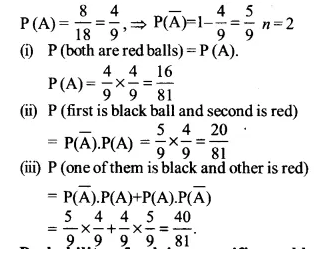
Ex 13.2 Class 12 Maths Question 14
Probability of solving specific problem independently by A and B are \(\frac { 1 }{ 2 }\) and \(\frac { 1 }{ 3 }\) respectively. If both try to solve the problem independently, find the probability that
(i) the problem is solved
(ii) exactly one of them solves the problem.
Solution.
Probability that A solves the problem = \(\frac { 1 }{ 2 }\)
=> Probablility that A does not solve the problem
P (A) = \(1-\frac { 1 }{ 2 } =\frac { 1 }{ 2 } \)
Probability that B solves the problem = \(\frac { 1 }{ 3 }\)
=> Probability that B does not solved the
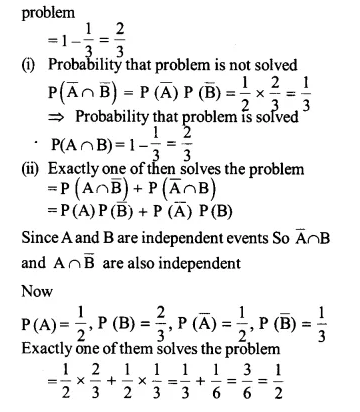
Ex 13.2 Class 12 Maths Question 15
One card is drawn at random from a well shuffled deck of 52 cards. In which of the following cases are the events E and F independent?
(i) E: ‘the card drawn is a spade’
F: ‘the card drawn is an ace ’
(ii) E: ‘the card drawn is black’
F: ‘the card drawn is a king’
(iii) E: ‘the card drawn is a king or queen ’
F: ‘the card drawn is a queen or jack ’.
Solution.
n(S) = 52
(i) E = {13 spades},P(E) = \(\frac { 13 }{ 52 }\) = \(\frac { 1 }{ 4 }\)
F = {4 aces}, P(F) = \(\frac { 4 }{ 52 }\) = \(\frac { 1 }{ 13 }\)
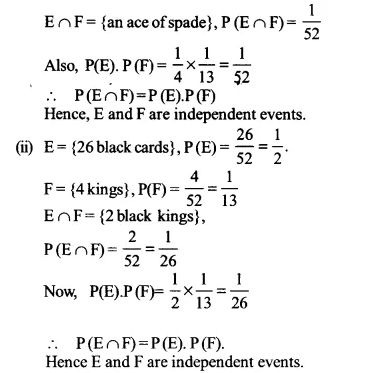
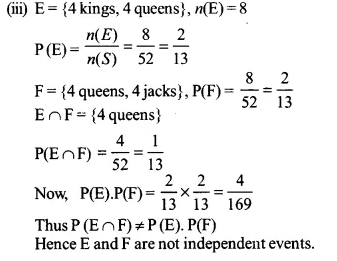
Ex 13.2 Class 12 Maths Question 16
In a hostel, 60% of the students read Hindi newspaper, 40% read English newspaper and 20% read both Hindi and English newspapers. A student is selected at random
(a) Find the probability that she reads neither Hindi nor English newspapers.
(b) If she reads Hindi newspaper, find the probabililty that she reads english newspapers.
(c) If she reads English newspaper, find the probability that she reads Hindi newspaper.
Solution.
(a) Let H and E represent the event that a student reads Hindi and English newspaper respectively
P (H) = 0.6, P (E) = 0.4, P (H ∩ E) = 0.2
Probability that the student reads at least one paper
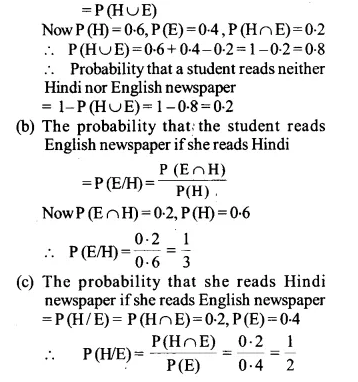
Choose the correct answer in the following Question 17 and 18:
Ex 13.2 Class 12 Maths Question 17
The probability of obtaining an even prime number on each die when a pair of dice is rolled is
(a) 0
(b) \(\frac { 1 }{ 3 }\)
(c) \(\frac { 1 }{ 12 }\)
(d) \(\frac { 1 }{ 36 }\)
Solution.
(d) n(S) = 36
Let A represents an even prime number one each dice.

Ex 13.2 Class 12 Maths Question 18
Two events A and B are said to be independent, if
(a) A and B are mutually exclusive
(b) P(A’B’) = [1 – P(A)] [1 – P(B)]
(c) P(A) = P(B)
(d) P (A) + P (B) = 1
Solution.
(b) P(A’and B’) = [1 – P(A)]. [1 – P(B) = P(A). P(B’)
Thus option (b) is correct.
NCERT Solutions for Class 12 Maths Chapter 13 Probability Ex 13.3
Ex 13.3 Class 12 Maths Question 1.
An urn contain 5 red and 5 black balls. A ball is drawn at random, its colour is noted and is returned to the urn. Moreover, 2 additional balls of the colour drawn are put in the urn and then a ball is drawn at random.What is the probability that the second ball is red?
Solution.
Urn contain 5 red and 5 black balls.
(i) Let a red ball is drawn.
probability of drawing a red ball = \(\frac { 5 }{ 10 }\) = \(\frac { 1 }{ 2 }\)
Now two red balls are added to the urn.
=> The urn contains 7 red and 5 black balls.
Probability of drawing a red ball = \(\frac { 7 }{ 12 }\)
(ii) Let a black ball is drawn at first attempt
Probability of drawing a black ball = \(\frac { 5 }{ 10 }\) = \(\frac { 1 }{ 2 }\)
Next two black balls are added to the urn
Now urn contains 5 red and 7 black balls
Probability of getting a red ball = \(\frac { 5 }{ 12 }\)
=> Probability of drawing a second ball as red
\(=\frac { 1 }{ 2 } \times \frac { 7 }{ 12 } +\frac { 1 }{ 2 } \times \frac { 5 }{ 12 } =\frac { 7 }{ 24 } +\frac { 5 }{ 24 } =\frac { 12 }{ 24 } =\frac { 1 }{ 2 } \)
Ex 13.3 Class 12 Maths Question 2.
A bag contains 4 red and 4 black balls, another bag contains 2 red and 6 black balls. One of the two bags is selected at random and a ball is drawn from the bag which is found to be red. Find the probability that the ball is drawn from the first bag.
Solution.
Let A be the event that ball drawn is red and let E1 and E2 be the events that the ball drawn is from the first bag and second bag
respectively. P(E1) = \(\frac { 1 }{ 2 }\), P(E2) = \(\frac { 1 }{ 2 }\).
P (A|E 1) = Probability of drawing a red ball from bag
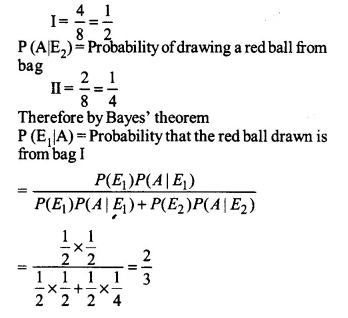
Ex 13.3 Class 12 Maths Question 3.
Of the students In a college, it is known that 60% reside In hostel and 40% are day scholars (not residing In hostel). Previous year results report that 30% of all students who reside in hostel attain A grade and 20% of day scholars attain A grade in their annual examination. At the end of the year, one student Is chosen at random from the college and he has an A- grade what Is the probability that the student is a hostlier?
Solution.
Let E1, E2 and A represents the following:
E1 = students residing in the hostel,
E2 day scholars (not residing in the hostel)
and A = students who attain grade A
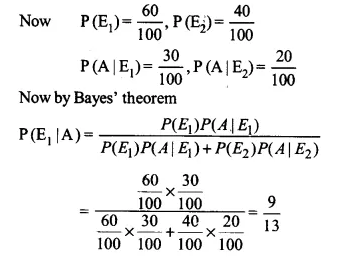
Ex 13.3 Class 12 Maths Question 4.
In answering a question on a multiple choice test, a student either knows the answer or 3 guesses. Let \(\frac { 3 }{ 4 }\) be the probability that he knows the answer and \(\frac { 1 }{ 4 }\) be the probability that he guesses. Assuming that a student who guesses at the answer will be correct with probability \(\frac { 1 }{ 4 }\) . What is the probability that the student knows the answer given that he answered it correctly?
Solution.
Let the event E1 = student knows the answer , E2 = He gusses the answer
P(E1) = \(\frac { 3 }{ 4 }\),P(E2) = \(\frac { 1 }{ 4 }\)
Let A is the event that answer is correct, if the student knows the answer
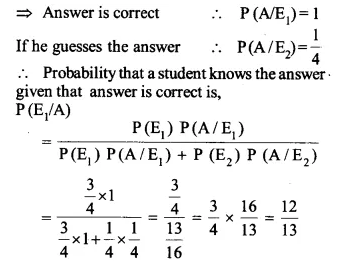
Ex 13.3 Class 12 Maths Question 5.
A laboratory blood test is 99% effective in detecting a certain disease when it is, in fact, present. However, the test also yields a false positive result for 0.5% of the healthy person tested (i.e. if a healthy person is tested, then, with probability 0.005, the test will imply he has the disease). If 0.1 percent of the population actually has the disease, what is the probability that a person has the disease given that his test result is positive?
Solution.
Let
E1 = The person selected is suffering from certain disease,
E2 = The person selected is not suffering from certain disease.
A = The doctor diagnoses correctly
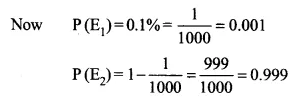
Ex 13.3 Class 12 Maths Question 6.
There are three coins. One is a two headed coin, another is a biased coin that conies up heads 75% of the time and third is an unbiased coin. One of the three coins is choosen at random and tossed, it shows head, what is the probability that it was the two headed coin?
Solution.
Let E1, E2, E3 and A denotes the following:
E1 = a two headed coin, E2 = a biased coin,
E3 = an unbiased coin, A=A head is shown
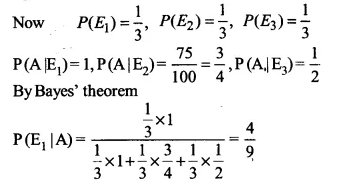
Ex 13.3 Class 12 Maths Question 7.
An insurance company insured 2000 scooter drivers, 4000 car drivers and 6000 truck drivers. The probability of mi accident are 0.01, 0.03, 0.15 respectively. One of the insured persons meets with an accident. What is the probability that he is a scooter driver?
Solution.
An insurance company insured 2000 scooter drivers, 4000 car drivers and 6000 truck drivers. Total number of drivers
=2000 + 4000 + 6000 = 12,000
Probability of selecting a scooter driver
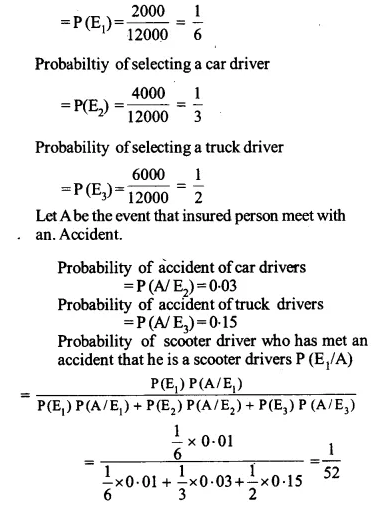
Ex 13.3 Class 12 Maths Question 8
A factory has two machines A and B. Past record shows that machine A produced 60% of the items of output and machine B produced 40% of the items. Further, 2% of the items produced by machine A and 1% produced by machine B were defective.All the items are put into one stockpile and then one item is chosen at random from this and is found to be defective. What is the probability that it was produced by machine B.?
Solution.
E1 and E2 are the events the percentage of production of items by machine A and machine B respectively.
Let A denotes defective item.
Machine A’s production of items = 60 %
Probability of production of items by machine
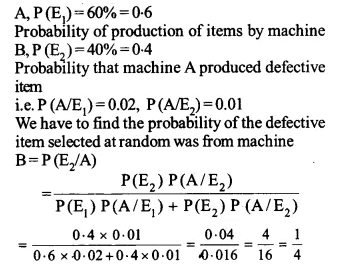
Ex 13.3 Class 12 Maths Question 9.
Two groups are competing for the position on the Board of directors of a corporation. The probabilities that the first and the second groups will win are 0.6 and 0.4 respectively. Further, if the first group wins, the probability of introducing a new product is 0.7 and the corresponding probability is 0.3 if the second group wins. Find the probability that the new product introduced was by the second group.
Solution.
Given: P (G1) = 0.6, P (G2) = 0.4
P represents the launching of new product P(P|G1) = 0.7 and P(P|G2) = 0.3
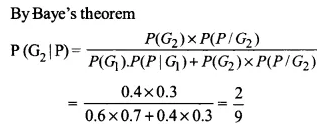
Ex 13.3 Class 12 Maths Question 10.
Suppose a girl throws a die. If she gets a 5 or 6, she tosses a coin three times and notes the number of heads.If she gets 1,2,3 or 4, she tosses a coin once and notes whether a head or tail is obtained. If she obtained exactly one head, what is the probability that she threw 1,2,3, or 4 with the die?
Solution.
When a die is thrown there are 6 exhaustive cases.
If she gets 5 or 6 the probability of E1 = \(\frac { 2 }{ 6 }\) = \(\frac { 1 }{ 3 }\)
i.e.,P(E1) = \(\frac { 1 }{ 3 }\)
If she gets 1,2,3,4 and probability of E2 = \(\frac { 4 }{ 6 }\) = \(\frac { 2 }{ 3 }\)
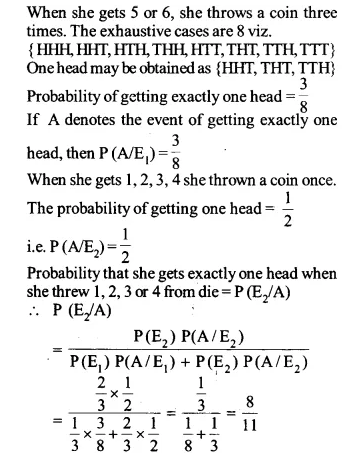
Ex 13.3 Class 12 Maths Question 11.
A manufacturer has three machine operators A, B and C. The first operator A produces 1% defective items, where as the other two operators B and C produce 5% and 7% defective items respectively. A is on the job for 50% of the time, B is on the job for 30% of the time and C is on the job for 20% of the time. A defective item is produced, what is the probability that it was produced by A?
Solution.
Let E1, E2, E3 and A be the events defined as follows:
E1 = the item is manufactured by the operator A
E2 = the item is manufactured by the operator B
E3 = the item is manufactured by the operator C
and A=the item is defective
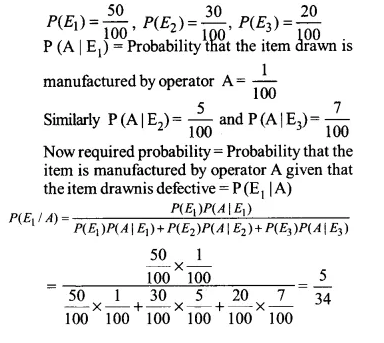
Ex 13.3 Class 12 Maths Question 12.
A card from a pack of 52 cards is lost From the remaining cards of the pack, two cards are drawn and are found to be both diamonds. Find the probability of the lost card being a diamond?
Solution.
E1 = Event that lost card is diamond,
E2 = Event that lost card is not diamond.
There are 13 diamond cards, out of a pack or 52 cards
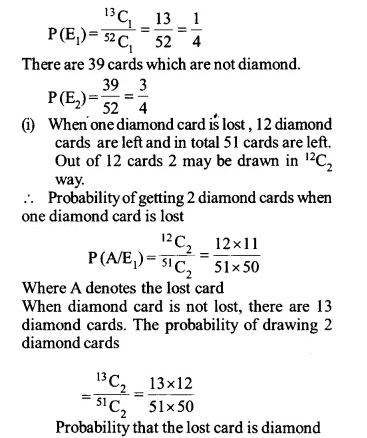
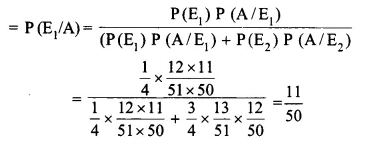
Ex 13.3 Class 12 Maths Question 13.
Probability that A speaks truth is 4/5. A coin is tossed. A reports that a head appears. The probability that actually there was head is
(a) \(\frac { 4 }{ 5 }\)
(b) \(\frac { 1 }{ 2 }\)
(c) \(\frac { 1 }{ 5 }\)
(d) \(\frac { 2 }{ 5 }\)
Solution.
Let A be the event that the man reports that head occurs in tossing a coin and let E1 be the event that head occurs and E2 be the event head does not occurs.
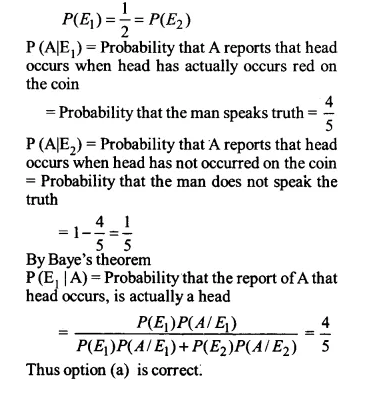
Ex 13.3 Class 12 Maths Question 14.
If A and B are two events such that A⊂B and P (B) ≠ 0, then which of the following is correct:
(a) P(A | B) = \(\frac { P(B) }{ P(A) }\)
(b) P (A | B) < P (A)
(c) P(A | B) ≥ P(A)
(d) None of these
Solution.
(c) A⊂B => A∩B = A and P(B)≠0
\(P(A|B)=\frac { P(A\cap B) }{ P(B) } =\frac { P(A) }{ P(B) } \)

NCERT Solutions for Class 12 Maths Chapter 13 Probability Ex 13.4
Ex 13.4 Class 12 Maths Question 1.
State which of the following are not the probability distributions of a random variable. Give reasons for your answer.
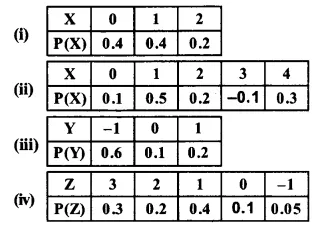
Solution.
P (0) + P (1) + P (2) = 0.4 + 0.4 + 0.2 = 1
It is a probability distribution.
(ii) P (3) = -0.1 which is not possible.
Thus it is not a probability distribution.
(iii) P(-1)+P(0)+P(1) = 0.6 + 0.1 + 0.2 = 0.9≠1
Thus it is not a probability distribution.
(iv) P (3) + P (2) + P (1) + P (0) + P (-1)
= 0.3 + 0.2 + 0.4 + 0.1 + 0.05 = 1.05≠1
Hence it is not a probability distribution.
Ex 13.4 Class 12 Maths Question 2.
An urn contains 5 red and 2 black balls. Two balls are randomly drawn. Let X represent the number of black balls. What are the possible values of X ?. Is X a random variable?
Solution.
These two balls may be selected as RR, RB, BR, BB, where R represents red and B represents black ball, variable X has the value 0,1,2, i.e., there may be no black balls, may be one black ball, or both the balls are.black. Yes , X is a random variable.
Ex 13.4 Class 12 Maths Question 3.
Let X represent the difference between the number of heads and the number of tails obtained when a coin is tossed 6 times. What are possible values of X?
Solution.
For one coin, S = {H,T}
n (S) = 2, Let A represent Head
∴ A = {H},n(A) = 1
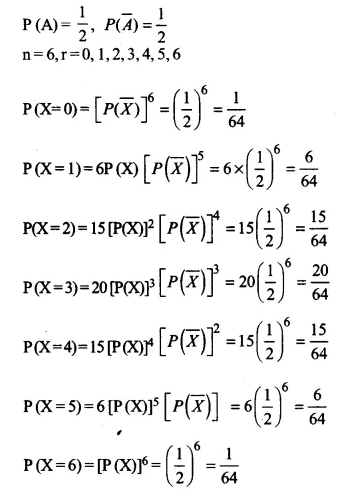
Ex 13.4 Class 12 Maths Question 4.
Find the probability distribution of
(a) number of heads in two tosses of a coin.
(b) number of tails in the simultaneous tosses of three coins.
(c) number of heads in four tosses of a coin.
Solution.
(a) When two tosses of a coin are there sample space
= {TT, TH, HT, HH}
Zero success => No heads => Two tails (TT)
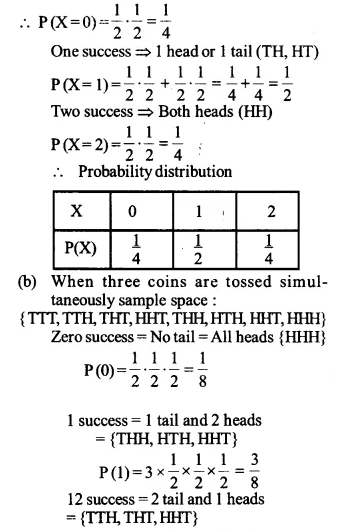
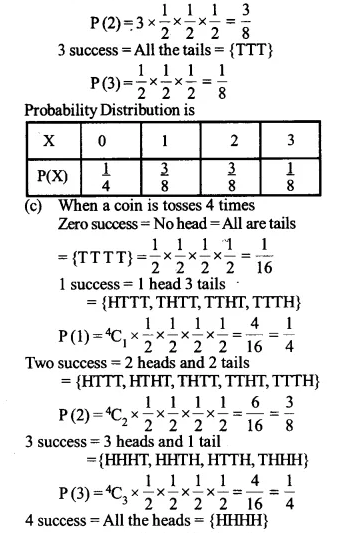
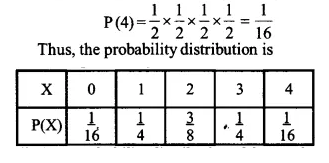
Ex 13.4 Class 12 Maths Question 5.
Find the probability distribution of the number of successes in two tosses of a die where a success Is defined as
(i) number greater than 4
(ii) six appears on at least one die
Solution.
S = (1, 2, 3,4, 5,6},n(S) = 6
(i) Let A be the set of favorable events.
A = {5,6),n(A) = 2

Ex 13.4 Class 12 Maths Question 6.
From a lot of 30 bulbs which include 6 defectives, a sample of 4 bulbs is drawn at random with replacement Find the probability distribution of the number of defective bulbs.
Solution.
There are 30 bulbs which include 6 defective bulbs
Probability of getting a defective bulb = \(\frac { 6 }{ 30 }\) = \(\frac { 1 }{ 5 }\)
Probability of getting a good bulb = \(1-\frac { 1 }{ 5 }\) = \(\frac { 4 }{ 5 }\)
Let X denotes variable of defective bulbs in a sample of 4 bulb
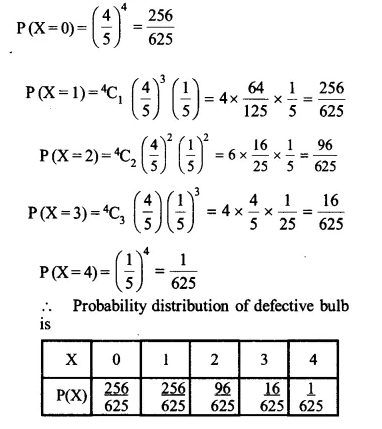
Ex 13.4 Class 12 Maths Question 7.
A coin is biased so that the head is 3 times as likely to occur as tail. If the coin is tossed twice, find the probability distribution of number of tads.
Solution.
Let p represents the appearance of tail.
q represents the appearance of head.
Now q = 3p As p + q = 1 => p + 3p = 1
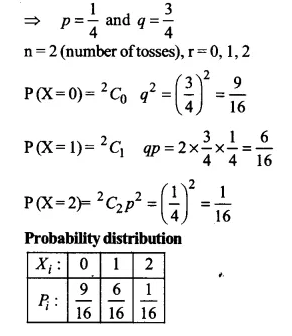
Ex 13.4 Class 12 Maths Question 8
A random variable X has the following probability distribution:

Determine
(i) k
(ii) P(X<3) (iii) P(X>6)
(iv) P(0<X<3)
Solution.
(i) Sum of probabilities = 1
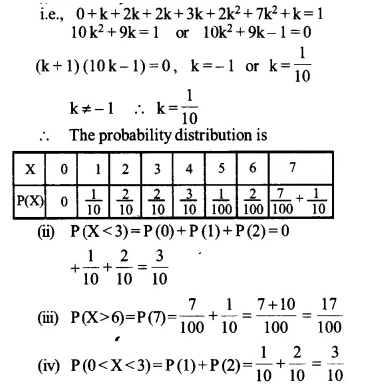
Ex 13.4 Class 12 Maths Question 9.
The random variable X has a probability distribution P (X) of the following form, where k is some number
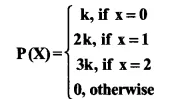
(a) Determine the value of k
(b) FindP(X<2),P (X≤2), P(X≥2)
Solution.
(a) Sum of probabilities = 1
k + 2k + 3k = 1 or 6k = 1,k = \(\frac { 1 }{ 6 }\)
The probability distribution is as given below
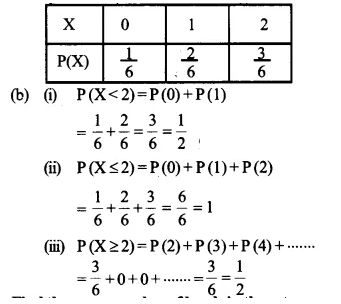
Ex 13.4 Class 12 Maths Question 10.
Find the mean number of heads in three tosses of a fair coin.
Solution.
S = {H,T},n(S) = 2
Let A denotes the appearance of head on a toss A = {H}
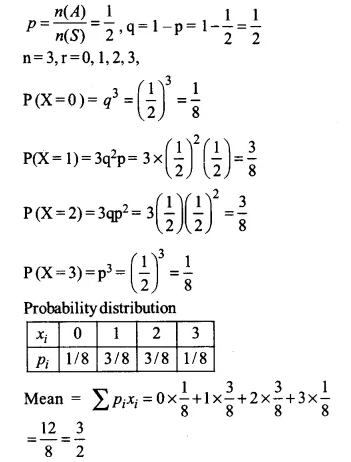
Ex 13.4 Class 12 Maths Question 11.
Two dice are thrown simultaneously. If X denotes the number of sixes, find the expectation of X.
Solution.
Two dice thrown simultaneously is the same the die thrown 2 times.
Let S= {1,2,3,4,5,6},n(S) = 6
Let A denotes the number 6
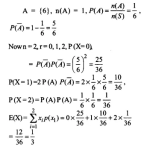
Ex 13.4 Class 12 Maths Question 12.
Two numbers are selected at random (without replacement) from the first six positive integers. Let X denote the larger of the two numbers obtained. Find E (X)
Solution.
There are six numbers 1,2,3,4,5,6 one of them is selected in 6 ways
When one of the numbers has been selected, 5 numbers are left, one number out of 5 may be select in 5 ways
∴ No. of ways of selecting two numbers without replacement out of 6 positive integers = 6 x 5 = 30
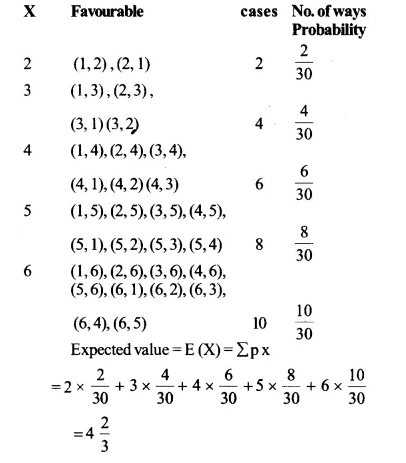
Ex 13.4 Class 12 Maths Question 13.
Let X denote the sum of the numbers obtained when two fair dice are rolled. Find the variance and standard deviation of X.
Solution.
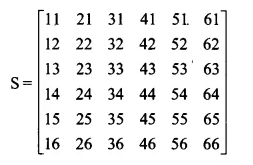
n (S) = 36
Let A denotes the sum of the numbers = 2
B denotes the sum of the numbers = 3
C denotes the sum of the numbers = 4
D denotes the sum of the numbers = 5
E denotes the sum of the numbers = 6
F denotes the sum of the numbers = 7
G denotes the sum of the numbers = 8
H denotes the sum of the numbers = 9
I denotes the sum of the numbers = 10
J denotes the sum of the numbers = 11
K denotes the sum of the numbers = 12
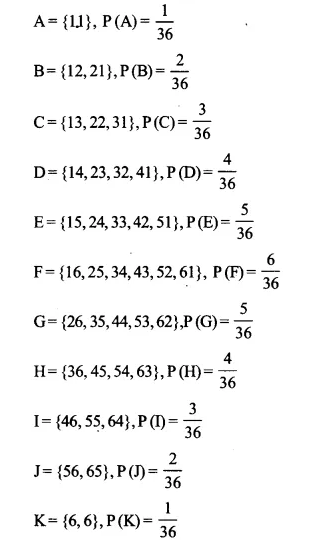
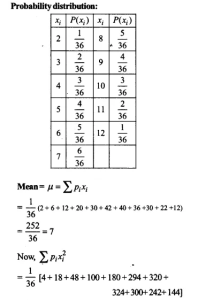
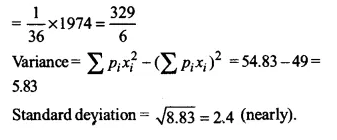
Ex 13.4 Class 12 Maths Question 14.
A class has 15 students whose ages are 14,17, 15,14,21,17,19,20,16,18,20,17,16,19 and 20 years. One student is selected in such a manner that each has the same chance of being chosen and the age X of the selected student is recorded.What is the probability distribution of the random variable X ? Find mean, variance and standard deviation of X?
Solution.
There are 15 students in a class. Each has the same chance of being choosen.
The probability of each student to be selected
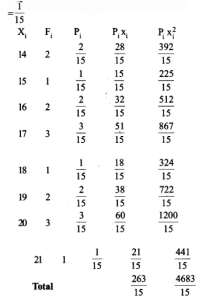
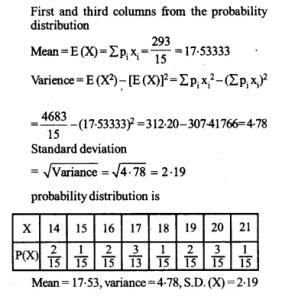
Ex 13.4 Class 12 Maths Question 15.
In a meeting, 70% of the members favour and 30% oppose a certain proposal. A member is selected at random and we take X = 0, if he opposed, and X = 1, if he is in favour Find E (X) and Var (X).
Solution.
Here the variable values are 1 and 0 and the probability of occurrence is 70% = 0.7 and 30% = 0.3
Probability distribution is
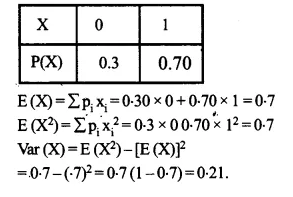
Choose the correct answer in each of the following:
Ex 13.4 Class 12 Maths Question 16.
The mean of the number obtained on throwing a die having written 1 on three faces, 2 on two faces and 5 on one face is
(a) 1
(b) 2
(c) 5
(d) \(\frac { 8 }{ 3 }\)
Solution.
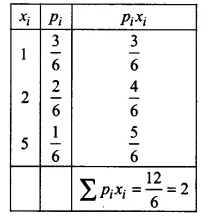
Mean 2
Option (b) is correct
Ex 13.4 Class 12 Maths Question 17.
Suppose that two cards are drawn at random from a deck of cards. Let X be the number of aces obtained. What is the value of E (X)?
(a) \(\frac { 37 }{ 221 }\)
(b) \(\frac { 5 }{ 13 }\)
(c) \(\frac { 1 }{ 13 }\)
(d) \(\frac { 2 }{ 13 }\)
Solution.
n(S) = 52, n(A) = 4
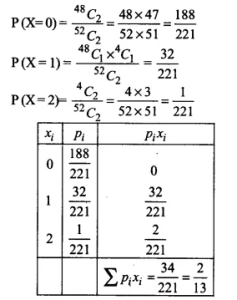
Now E(X) = \(\frac { 2 }{ 13 }\)
Option (d) is correct
NCERT Solutions for Class 12 Maths Chapter 13 Probability Ex 13.5
Ex 13.5 Class 12 Maths Question 1.
A die is thrown 6 times. If ‘getting an odd number’ is a success, what is the probability of
(i) 5 successes?
(ii) at least 5 successes?
(iii) at most 5 successes?
Solution.
There are 3 odd numbers on a die
∴ Probability of getting an odd number on a die = \(\frac { 3 }{ 6 }\) = \(\frac { 1 }{ 2 }\)
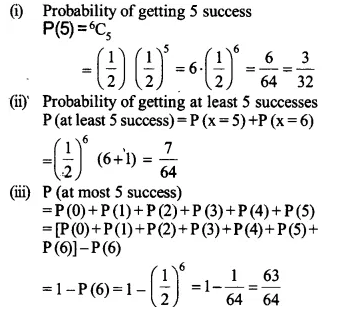
Ex 13.5 Class 12 Maths Question 2.
There are 5% defective items in a large bulk of items. What is the probability that a sample of 10 items will include not more than one defective item ?
Solution.
Probability of getting one defective item = 5%
= \(\frac { 5 }{ 100 }\)
= \(\frac { 1 }{ 20 }\)
Probability of getting a good item = \(1-\frac { 1 }{ 20 }\) = \(\frac { 19 }{ 20 }\)
A sample of 10 item include not more than one defective item.
=> sample contains at most (me defective item Its probability = P (0) + P (1)
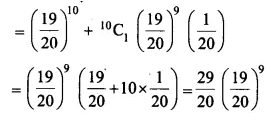
Ex 13.5 Class 12 Maths Question 3.
A pair of dice is thrown 4 times. If getting a doublet is considered a success, find the probability, of two successes.
Solution.
n(S) = 36, A = {11,22,33,44,55,66}
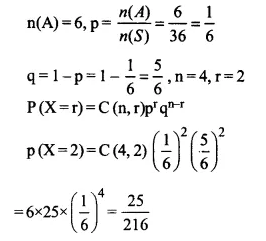
Ex 13.5 Class 12 Maths Question 4.
Five cards are drawn successively with replacement from a well- shuffled deck of 52 cards. What is the probability that
(i) all the five cards are spades?
(ii) only 3 cards are spades?
(iii) none is spade?
Solution.
S = {52 cards}, n (S) = 52
Let A denotes the favourable events
A= {13 spade}, n(A)= 13
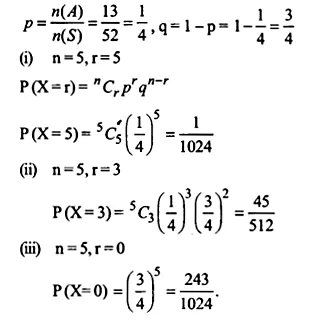
Ex 13.5 Class 12 Maths Question 5.
The probability that a bulb produced by a factory will fuse after 150 days of use is 0.05. Find the probability that out of 5 such bulbs.
(i) none
(ii) not more than one
(iii) more than one
(iv) at least one will fuse after 150 days of use
Solution.
Probability that a bulb gets fuse after 150 days of its use = 0.05
Probability that the bulb will not fuse after 150 days of its use = 1 – 0.05 = 0.95
(i) Probability that no bulb will fuse after 150
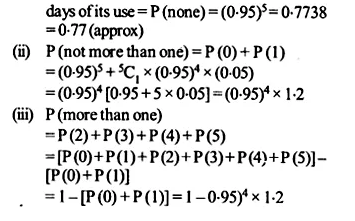
Ex 13.5 Class 12 Maths Question 6.
A bag consists of 10 balls each marked with one of the digits 0 to 9. If four bails are drawn successively with replacement from the bag, what is the probability that none is marked with the digit 0?
Solution.
S = {0,1,2,3,4,5,6,7,8,9},n(S) = 10
Let A represents that the ball is marked with the digit 0.
A = {0}, n(A) = 1
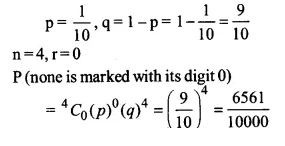
Ex 13.5 Class 12 Maths Question 7.
In an examination, 20 questions of true – false type are asked. Suppose a student tosses fair coin to determine his answer to each question. If the coin falls heads, he answers ‘true,’ if it falls tails, he answers “ false’. Find the probability that he answers at least 12 questions correctly.
Solution.
Probability that student answers a question true = \(\frac { 1 }{ 2 }\)
i.e., when a coin is thrown, probability that a head is obtained = \(\frac { 1 }{ 2 }\)
Probability that his answer is false = \(1-\frac { 1 }{ 2 }\) = \(\frac { 1 }{ 2 }\)
Probability that his answer at least 12 questions correctly = P (12) + P (13) + P (14) +…….. P (20)
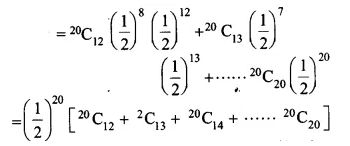
Ex 13.5 Class 12 Maths Question 8
Suppose X has a binomial distribution \(B\left( 6,\frac { 1 }{ 2 } \right) \). Show that X = 3 is the most likely outcome.
(Hint: P (X = 3) is the maximum among all P (Xi), xi. = 0,1,2,3,4,5,6)
Solution.
\({ \left( \frac { 1 }{ 2 } +\frac { 1 }{ 2 } \right) }^{ 6 } \)

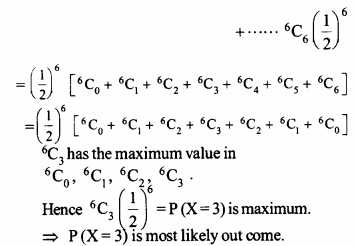
Ex 13.5 Class 12 Maths Question 9.
On a multiple choice examination with three possible answers for each of the five questions, what is the probability that a candidate would get four or more correct answers just by guessing?
Solution.
P = \(\frac { 1 }{ 3 }\). q = 1 – P = \(1-\frac { 1 }{ 3 }\) = \(\frac { 2 }{ 3 }\)
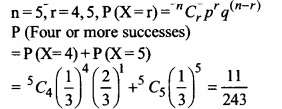
Ex 13.5 Class 12 Maths Question 10.
A person buys a lottery ticket in 50 lotteries, in each of which his chance of winning a prize is \(\frac { 1 }{ 100 }\) . What is the probability that he will win a prize?
(a) at least once,
(b) exactly once,
(c) at least twice?
Solution.
Probability that the person wins the prize = \(\frac { 1 }{ 100 }\)
Probability of losing = \(1-\frac { 1 }{ 100 }\) = \(\frac { 99 }{ 100 }\)
(a) Probability that he loses in all the loteries
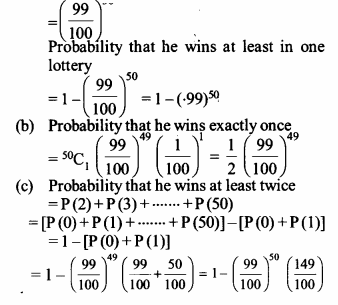
Ex 13.5 Class 12 Maths Question 11.
Find the probability of getting 5 exactly twice in 7 throws of a die.
Solution.
S = {1,2,3,4,5,6},n(S) = 6
A = {5} => n(A) = 1
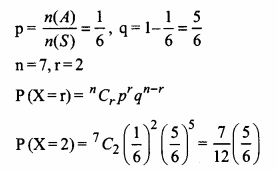
Ex 13.5 Class 12 Maths Question 12.
Find the probability of throwing at most 2 sixes in 6 throws of a single die.
Solution.
When a die is thrown,
Probabiltiy of getting a six = \(\frac { 1 }{ 6 }\)
Probabiltiy of not getting a six = \(1-\frac { 1 }{ 6 }\) = \(\frac { 5 }{ 6 }\)
Probabiltiy of getting at most 2 sixes in 6 throws of a single die = P (0) + P (1) + P (2)
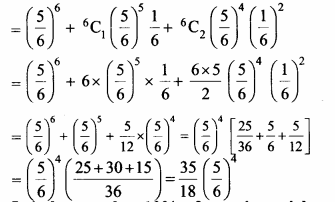
Ex 13.5 Class 12 Maths Question 13.
It is known that 10% of certain articles manufactured are defective. What is the probability that in a random sample of 12 such articles 9 are defective?
Solution.
p = \(\frac { 1 }{ 100 }\) = \(\frac { 1 }{ 10 }\)
q = 1 – p = \(1-\frac { 1 }{ 10 }\) = \(\frac { 9 }{ 10 }\)
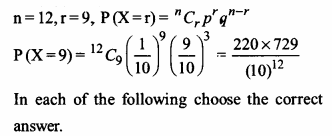
Ex 13.5 Class 12 Maths Question 14.
In a box containing 100 bulbs, 10 are defective. The probability that out of a sample of 5 bulbs, none is defective is
(a) \({ 10 }^{ -1 }\)
(b) \({ \left( \frac { 1 }{ 2 } \right) }^{ 5 }\)
(c) \({ \left( \frac { 9 }{ 10 } \right) }^{ 5 }\)
(d) \(\frac { 9 }{ 10 }\)
Solution.
p = \(\frac { 1 }{ 10 }\)
q = \(\frac { 9 }{ 10 }\) n = 5, r = 0, P(X=0) = \({ \left( \frac { 9 }{ 10 } \right) }^{ 5 }\)
Option (c) is correct
Ex 13.5 Class 12 Maths Question 15.
The probability that a student is not a swimmer is \(\frac { 1 }{ 5 }\). Then the probability that out of five students, four are swimmers is:

Solution.
p = \(\frac { 4 }{ 5 }\) , q = \(\frac { 1 }{ 5 }\) , n = 5,r = 4
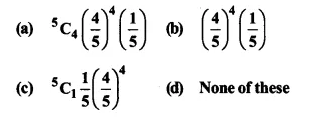

Option (a) is true
NCERT Class 12 Maths
Class 12 Maths Chapters | Maths Class 12 Chapter 13
Chapterwise NCERT Solutions for Class 12 Maths
-
NCERT Solutions For Class 12 Maths Chapter 1 Relations and Functions
NCERT Solutions For Class 12 Maths Chapter 2 Inverse Trigonometric Functions
NCERT Solutions For Class 12 Maths Chapter 3 Matrix
NCERT Solutions For Class 12 Maths Chapter 4 Determinants
NCERT Solutions For Class 12 Maths Chapter 5 Continuity and Differentiability
NCERT Solutions For Class 12 Maths Chapter 6 Application of Derivatives
NCERT Solutions For Class 12 Maths Chapter 7 Integrals
NCERT Solutions For Class 12 Maths Chapter 8 Application of Integrals
NCERT Solutions For Class 12 Maths Chapter 9 Differential Equations
NCERT Solutions For Class 12 Maths Chapter 10 Vector Algebra
NCERT Solutions For Class 12 Maths Chapter 11 Three-dimensional Geometry
NCERT Solutions For Class 12 Maths Chapter 12 Linear Programming
NCERT Solutions For Class 12 Maths Chapter 13 Probability
| NCERT Solutions for Class 12 All Subjects | NCERT Solutions for Class 10 All Subjects |
| NCERT Solutions for Class 11 All Subjects | NCERT Solutions for Class 9 All Subjects |

Post a Comment
इस पेज / वेबसाइट की त्रुटियों / गलतियों को यहाँ दर्ज कीजिये
(Errors/mistakes on this page/website enter here)